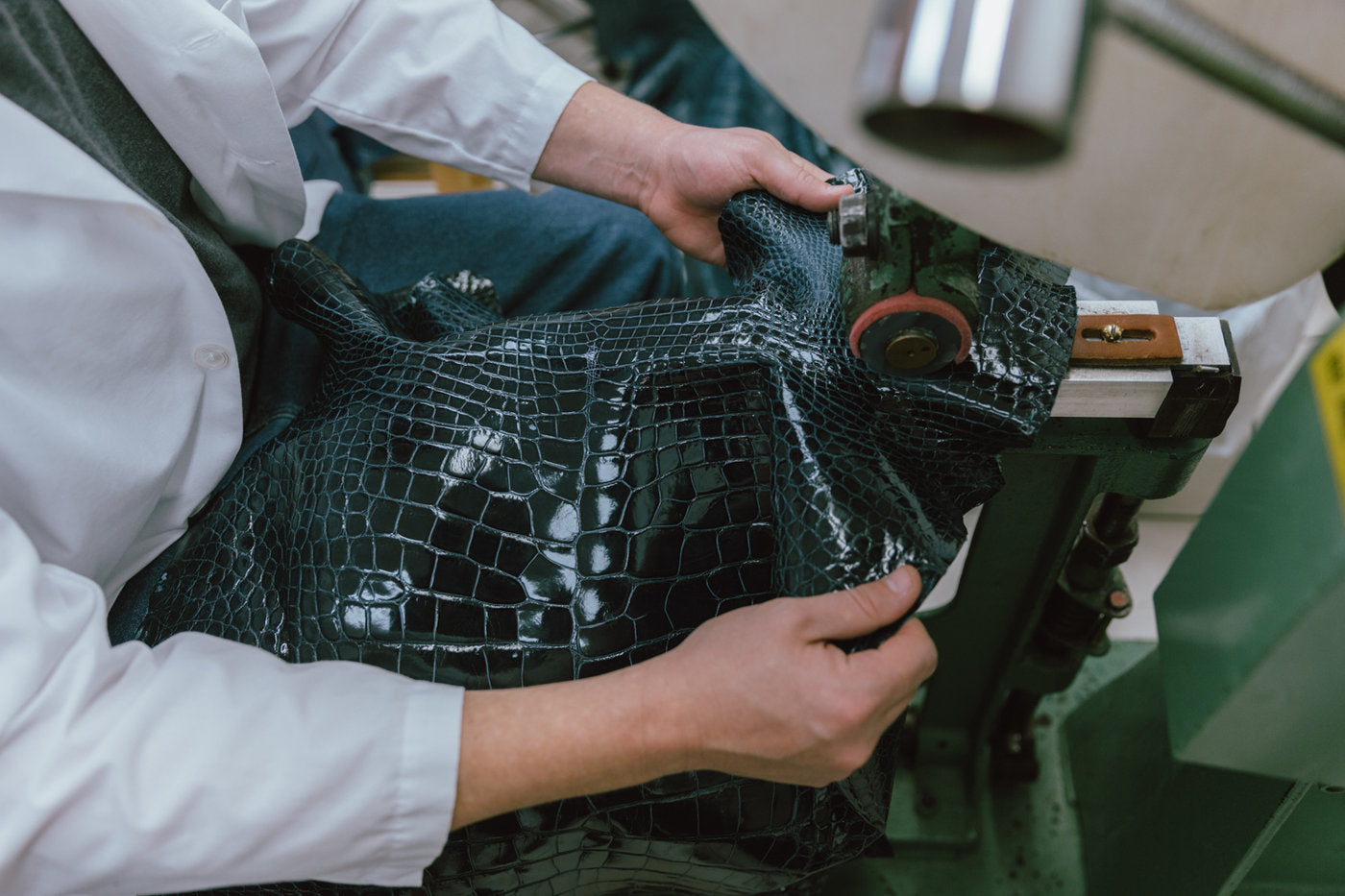
The Art of Tanning
The Process
Each tannery’s proprietary technology is a highly protected secret. We would like to share some basic information (without sharing any of our confidential techniques or recipes), so you can better understand our process of reptile tanning and why alligator skins are so precious.
-

Descaling
The first important processes of tanning exotic leathers are soaking and descaling. During this key step, batches of skins (or lots) are placed in huge paddle tanks filled with water and other processing materials which gently dissolve the scaly layer of the skin, while the paddle softly agitates the water to "open up" the skin and encourage the sloughing of the scales. After 7-10 days, when the grain of the skin is exposed and the pH of the water is adjusted, the skins are ready for tanning.
-

Chroming
The tanning of the skins takes place in large drums which are filled with water and other solutions, one of which is a mineral based tanning substance called "chrome". The skins will churn in the drums over the course of the next several days.
-

Wet-Blue
Once removed from the drums, the skins have changed into a rubbery, leathery state known as "wet-blue". Skins are held in wet-blue for a period of several weeks to ensure the tannage is complete and the chrome becomes firmly bound in the skin.
-

Shaving
After the skins have "rested" in the wet-blue phase, they are shaved to a uniform thickness by a machinist who skillfully operates a high speed rotating blade. Each skin is meticulously checked after shaving to ensure strict rigorous quality standards are met.
-

Crust
After shaving, skins are readied for the bleaching, neutralization and re-tanning phase to begin. The skins are placed into huge drums where natural markings and pigment in the skins are removed. All free radicals / acids in the skins are neutralized and the exact characteristics of the leather are imparted into the skin by the addition of synthetic or vegetable re-tanning extracts. Finally, specially formulated "fat liquor" oils are added to the skins to achieve the perfect touch and enhance the beauty of the leather.
-

Selection
AMTAN selects skins for each customer order according to their needs. Crust skins are carefully checked with cutting patterns in order to be sure the correct size and selection is matched to the customer request.
-

Dyeing
Once skins are batched for coloring, they are placed in specialized rotating drums along with dyes, oils, and colorants which must be meticulously blended and added in exact sequence to achieve a beautiful and level dyeing of the leather. Each dye formulation is crafted using the finest dyes available. During the dyeing process, the skins are again shaved to achieve the correct thickness for each finish and to facilitate a smooth, uniform finish on the leather.
-

Toggling
Once the skins are removed from the dyeing drums, the skins are “toggled” flat or tacked onto boards to dry. The dyeing process can take several days. Each finish requires its own unique dyeing process; therefore, matte finish and glazed finish skins are dyed with formulation. To further clarify: we cannot dye skins black and finish half of lot as matte finish and the other half as glazed finish.
-

Glazed Finishing
Once the skins are dried, they are prepared for finishing. Each finish produced by AMTAN has its own special recipe and polishing method. Glazed leather is produced by polishing the skins with an agate stone, which takes between 30 minutes to 1 hour per skin. That means that a typical glazing technician can only produce between 8-10 skins per day.
-

Desert Finishing
Desert finished leather is seasoned with special polishing oils and waxes. We must also mill and stake the skins to achieve optimal softness and temper. Finally, the skins are either hand polished with a special soft bristle brush or with a felt polishing wheel on a special machine.
-

Millennium Finishing
Millennium finish is produced by placing the skin through a special roller press which applies heat and pressure to create a soft glow on the leather. During the finishing process, skins are wet and dried sometimes several times, and this final step of making leather can take up to 7 working days.
-

Quality Control
Finally, once skins pass our rigorous quality control, they are ready to be graded, measured, and packed. Each skin is personally checked by a member of the Plott family before leaving the tannery and receiving the seal of approval to be delivered to our customers.












